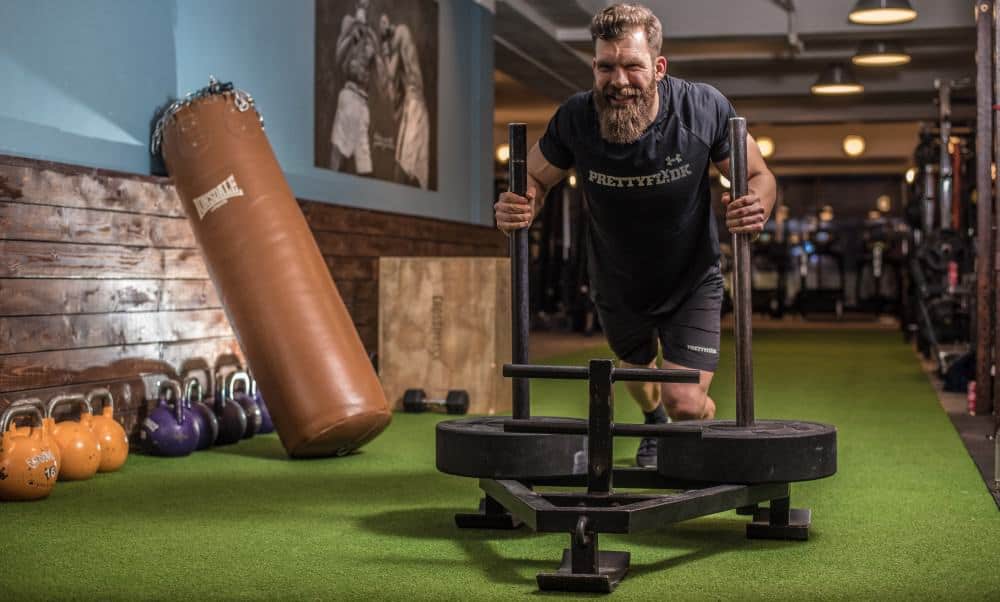
Sooner or later, each of you will come to this point, the training stagnates.
Until then, steady and easy training has worked and brought good results, but most likely this condition only lasts beyond the beginning.
Thus, the question arises as to how to proceed in such a phase.
What possibilities are there to rekindle the progression?
In this article, I will introduce you to the topic of overreaching in exercise and its symptoms and explain why this can help you.
To put it simply, overreaching is a condition in which fatigue is above our regenerative capacity.
You certainly know that hard training is the key to success.
But what happens when we train hard and constantly reach our limits?
In other words, what happens if we keep filling up our “exhaustion account”?
We overburden our entire system, leaving us in a state of exhaustion above our regenerative capacity.
This condition is called overreaching, which must be clearly differentiated from the state of overtraining.
However, overreaching can be strategically used to have even more success in training.
Important here is the word “strategic” because if we do not reduce this congestion in time, we can get into the state of overtraining.
The overtraining can be seen as a “hardcore variant” of overreaching.
While the negative consequences of overreaching can be completely remedied by a training break or a light training period, it takes several weeks or even months to fully regenerate during overtraining.
You are in overtraining if the symptoms do not disappear after a 1-2 week break.
While we can use overreaching strategically, we should avoid overtraining in any case.

Symptoms of Overreaching
How do we notice that we are in a state of overreaching?
In the following, I’ll give you a checklist that you can use to assess whether your current condition may reveal some of these symptoms and evaluate accordingly.
A wise man once said, “Knowledge is the first step to improvement.”
But how do we even realize that we are in overreaching?
1. Power loss/Stagnation
If you have been able to increase over several weeks and now stagnate or even become weaker, even though you have kept everything else such as sleep, nutrition, etc. constant.
2. Increased awareness of the effort in training
When the workout suddenly feels a lot heavier and tougher.
3. Bad sleep
If you suddenly restlessly sleep or the duration of your sleep decreases sharply.
4. Changed heart rate/changed blood pressure
Suddenly, your resting heart rate or your blood pressure changes.
5.Bad Mood
You suddenly have a bad mood and are irritated much faster.
6.Joint pain/overload
The training does not feel so “smooth” and one or the other joint reveals complaints.
In general, increased stress, in our particular case increased exercise stress, has been associated with anxiety, lack of motivation, irritability, and insomnia.
It is important to note that not all symptoms must occur simultaneously.
In the following graph, you can see a possible course of exhaustion and its consequences.
In our example, we look at a period of 20 hard training weeks.
Already from the first week we diligently accumulate exhaustion and thus land in week 4 in overreaching.
At this time, we should already feel some of the above symptoms more or less. However, if we just ignore them and continue training as usual, so do not reduce the exhaustion, we finally get into overtraining in week 20.
Ideally, between week 4 and week 20, we would put in a light training period to avoid overtraining.
As you can see, you really have to ignore the overreaching symptoms before it gets too late.
So always listen to your body and push in if necessary just a light training week.
Otherwise, you have to expect very strong consequences, which can significantly negatively affect your training career. Irrespective of the fact that your remaining quality of life can be severely affected.

Is it necessary to use Overreaching?
Is overreaching necessary at all?
By no means. You can also achieve very good results without having to go to your regenerative limits.
In that case, you should always make sure that your exhaustion breaks down in time and your fatigue account is never completely filled. Besides, you do not have to be afraid of a possible overtraining.
Especially as a beginner, you do not need to worry about overreaching, because you can use clever training to evoke progression without heavily attacking your regeneration.
However, if you are no longer a beginner, strategic overreaching is probably essential to getting the most out of you.
Attention, we do not speak of average or good results, but of the best possible.
In that case, you simply have to train with a certain intensity, workload, and volume to maximize your results. You practically have to force your body to adapt and build muscle.
How do we get out of overreaching?
We need a period with less training stress to get out of the state of overreaching.
This can be done in the form of a training-free period or better in a light training period. The latter is called “Deload“, which I will discuss in the next article.
You also have to keep in mind that the above-mentioned symptoms of overreaching can occur isolated without overreaching. Just because you can no longer boost yourself does not mean that you are overloading or have too much stress.
On the contrary! Maybe the training stress for your body is no longer enough to induce adjustments.
In that case, you do not feel drained and usually have no other symptoms of overreaching.
Furthermore, it is always about a change in your shape and not about permanent conditions.
If you constantly have joint pain, sleep problems, bad mood, and co. the main problem will be elsewhere. Because these symptoms should disappear completely after a training-free time or a Deload and only appear slowly again before the next overreaching.
Training-induced overreaching is recognized by the periodic symptoms that are not present after the Deload and reappear shortly before the end of your exercise cycle.
Constant symptoms, such as a permanent lack of motivation or joint pain, probably have a different origin. The latter is caused in 99% of cases by a wrong technique in combination with too much weight.
In general, the more constant your life is, the easier it is for the symptoms to be due to exercise stress and not for sudden relationship problems or increased stress at work.
Overreaching can, therefore, tell you exactly by its characteristics, whether you are training too hard or too light:
- If you overreact too late or not at all, then you probably train too easy or too little.
- If you overreact too soon, then you probably train too hard or too much.

Why can we make a powerful statement?
Overreaching is the output of all inputs.
- Output: The result
- Input: Training stress, other stress, genetics, nutrition, recovery, psyche, environmental factors, training level, etc.
Of course, one can also distinguish between constant, semi-constant and variable inputs.
Constant and semi-constant inputs, such as environmental factors or genetics, are difficult or impossible to change during their lifetime.
Whereas variable inputs, such as exercise or calorie intake, are very easy to manipulate.
All these inputs determine our volume requirement and our volume tolerance, ie in concrete terms:
- How much training do we need?
- How much training can we handle?
If you get into overreaching after a week, you know that the training stress was too much for your personal situation.
If you never get into overreaching, then you know that you would have had the regenerative capacity to train harder or more voluminous.
Of course, it can also happen that someone gets into a state of overreaching by too much external stress, without having fully met his volume requirements.
In this case, more training also does not help, because the regeneration limit was obviously reached.
This person can only try to reduce the external stress or to live with the suboptimal but for his current situation optimal results.
Finally, we have to distinguish between two types of overreaching:
If there is a higher performance increase compared to a “normal” (not overreaching) training, then one speaks of a functional and if not a non-functional overreaching.
The latter describes a state between overreaching and overtraining. One would have had to put in a light training period earlier to avoid this scenario.
Summing Up
Let’s recap the take-home message of today’s article about what overreaching is in exercise and its symptoms.- Overreaching describes a condition in which exhaustion is above our regenerative capacity.
- It can be used strategically to have even more success but is not necessary for beginners.
- Overreaching helps us to evaluate our training stress.
- Overtraining is always to be avoided.
- The symptoms of overreaching do not necessarily occur simultaneously but can appear isolated.
I hope this article proved to be helpful for you, for any questions or concern about topics that you would like to hear from us, just leave a comment below or contact us through our social media channels.
After we’ve talked about overreaching now, however, its basis is to know your optimal volume.
Thus, for all of you who don’t have a clue about volume, your next logical step would be to catch up on it.
Want to know more about it? Check out my article about the Optimal Volume for Hypertrophy.
What is your experience with overreaching? Do you use overreaching in your training?
Let us know in the comments below!
Thanks for reading, guys
Claas





4 thoughts on “What is Overreaching in Exercise and its Symptoms?”
Pingback: What are Deloads and How do They Work? Complete Guide 2019 - Emerging Athlete
Pingback: The Optimal Side Delt Volume - Hypertrophy Guide - Emerging Athlete
Pingback: The Optimal Traps Volume - Hypertrophy Guide - Emerging Athlete
Pingback: The Optimal Triceps Volume - Hypertrophy Guide - Emerging Athlete